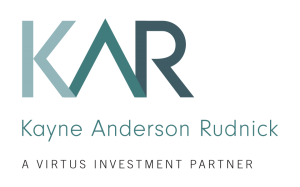
Julie Kutasov
Portfolio Manager and Senior Research Analyst
Kayne Anderson Rudnick
KAR portfolio manager Julie Kutasov reviews the performance of small-cap value equities in the fourth quarter, top contributors and detractors in the KAR Small-Cap Value strategy, and portfolio positioning for 2024.
Listen Now
Transcript
BEN FALCONE: Hello, this is Ben Falcone, managing director with Kayne Anderson Rudnick, and with me today, I have Julie Kutasov, portfolio manager of the KAR Small Cap Quality Value strategy.
JULIE KUTASOV: Hello, Ben. Happy to be here.
BEN FALCONE: Julie, equities had strong returns for the fourth quarter characterized by a broadening out of market returns that had previously been confined to a set of mega-cap stocks for the prior nine months of the year. Can you provide our listeners with your perspective on fourth quarter performance for small-cap value equities and how your portfolio performed during the quarter as well as the year?
JULIE KUTASOV: Sure. It was the decline in longer-term interest rates that drove equities’ strong performance during the fourth quarter. Stocks did drop in October when the 10-year US Treasury yield approached 5% for the first time in 16 years, but not for long. The rally began in early November as the 10-year Treasury yield started to decline, driven by a significant improvement in the inflation outlook, and continued following the Fed's December meeting as the market interpreted Chairman Powell's comments to mean the Fed was ready to stop rate hikes and even cut and pivot from the higher-for-longer expectations of just a quarter ago.
The fourth quarter's performance of the Russell 2000® Value Index was driven by companies with high earnings quality, stronger balance sheets, and low volatility—a favorable environment for us, as investors in high-quality companies. The strategy underperformed the benchmark during the quarter, however, primarily due to our underweight exposure to the outperforming banking segment. We have a structural low position in the segment due to its inherent capital intensity. Banks represent a nearly 18% weight in the Russell 2000 Value benchmark and returned over 28% during the quarter, as investors became more confident that short-term interest rates had peaked and banks' balance sheet quality had stabilized.
At the same time, we benefited from our lack of exposure to the energy sector, the only benchmark sector with a negative return for the quarter. Our underweight position in the energy sector is also structural in nature due to the sector's inherent capital intensity, cyclicality, and direct commodity exposure.
For the year as a whole, performance of the Russell 2000 Value Index was driven by companies with low earnings and balance sheet quality and high volatility, which is a more challenging environment for us. The strategy did outperform the benchmark for the year, however. We benefited from our overweight exposure to the outperforming industrials sector, underweight exposure to the underperforming healthcare sector, and lack of exposure to the underperforming utility sector.
Our underweight position in the utility sector is structural in nature due to the sector's inherent capital intensity, direct commodity exposure, and in the case of regulated utilities, capped returns. And this time, we benefited from our underweight position on banks with the benchmark’s banking segment posting a slightly negative return for the year.
BEN FALCONE: Julie, can you discuss a few of the portfolio holdings that were key contributors and detractors to performance within the quarter and for all of 2023?
JULIE KUTASOV: Bank of Hawaii was our highest stock contributor for the quarter. Other top contributors were Armstrong World Industries, Thor Industries, Azenta, and Watsco.
Bank of Hawaii is the second largest bank by deposits in the state of Hawaii. The bank has a very strong brand recognition among Hawaiians who tend to be loyal bank customers. The remoteness and high real estate costs of the islands creates significant barriers to entry. In the past, some of the largest mainland banks tried and failed in building a presence in Hawaii. Shares declined sharply in early March, driven by investor concerns over the banking segment, and moved higher during the quarter as investors became more positive on the short-term interest rate outlook.
For the year as a whole, our highest stock contributor was Watsco. Other top contributors were Thor Industries, Construction Partners, Houlihan Lokey, and Primerica.
Watsco is the nation's largest independent distributor of heating, ventilation, and air conditioning (or HVAC equipment) to residential and commercial contractors. Most revenues are related to repair and replacement activities, which, with HVAC being vital to human well being, are seldom discretionary. Shares performed strongly supported by the company's reports of solid operating results. We believe that Watsco will continue to benefit from its long-term relationships with equipment manufacturers, population migration to warmer states, as well as more stringent efficiency and refrigerant regulation that leads to sales of high-priced products and fast adoption and replacement cycles.
SiteOne Landscape Supply was our weakest performer during the quarter. Other detractors included John Bean Technologies Corporation, American Software, Latham Group, and REI Corporation.
SiteOne is the largest and only national wholesale distributor of landscape supplies. Due to its size, SiteOne is able to exert better pricing from suppliers, while at the same time, pricing it at a premium to customers, landscape professionals. Despite being the largest, the company holds a modest share of the highly fragmented landscape supplies distribution market, providing what we believe to be ample opportunity for revenue growth and further profitability expansion through industry consolidation. Shares lagged following the company's reports of greater-than-expected margin compression, with positive volume growth offset by price deflation. We view those issues as temporary and believe that the company's solid market positioning remains intact.
For the year as a whole, our weakest performer was Leslie’s. Other detractors included Stockyards Bank Corp., Bank of Hawaii (as we discussed, our top contributor for the quarter), American Software, and Universe Corporation.
Leslie’s is one of the leading specialty retailers in the pool and spa industry. The company offers regularly purchased items such as pool chemicals, equipment, cleaning accessories, and parts. From our perspective, the pool retail industry is an attractive one, with customers focused on outdoor spaces as well as continued population migration to warmer states expected to support growth over the long term. Once built, a pool needs to be maintained whether used or not. As a result, the majority of Leslie's business is non-discretionary recurring in nature, with 2022 marking the company's 59th consecutive year of revenue growth. Shares declined sharply in mid-July following the company's pronouncement of weaker-than-expected operating results and a significant reduction in annual sales outlook. Poor weather at the beginning of the pool season, along with customers overbuying in previous quarters, led to the disappointment.
We view these issues as temporary. From our perspective, the company's scale and brand power are stronger than competitors, and as retail becomes increasingly digital, we believe Leslie should benefit in comparison to smaller peers that do not have sufficient resources to compete. We also believe that the industry's spend on poor consumables and repair and remodel is intact despite current headwinds.
BEN FALCONE: Julie, as we head into 2024, thinking about the current backdrop for the economy as well as it being an election year, can you speak about how your portfolio is positioned relative to your benchmark?
JULIE KUTASOV: We are dealing with a great deal of uncertainty, elections’ outcome included this year, particularly on the geopolitical front as it relates to growing tensions, be it those surrounding Taiwan, the Russia-Ukraine conflict, or the war in the Middle East. In fact, we are already observing recent by Houthi rebels on commercial ships in the Red Sea having resulted in a steep rise in global freight rates and weeks-long shipment delays.
Importantly, inflation in the U.S. has come down meaningfully as supply chains have normalized and as labor markets have cooled. And consumer spending, the key driver of the U.S. economy, has held up well as easing inflation and strong wage growth boosted purchasing power. While improved inflation remains elevated, however, and December CPI data, released in January, suggests that inflation may be more stubborn than anticipated. And while the labor market continues to soften, it remains tight with wage inflation still running above the desired level. As the widely anticipated downturn failed to materialize, recession fears have given way to a soft landing outlook.
History tells us, however, that it does take time for interest rate increases to ripple through the economy. In the past 11 federal hiking cycles, recessions typically started about two years after the central bank began raising rates. This cycle started in March 2022. While we have been impressed and quite frankly surprised by the resilience of the US economy, an economic slowdown remains a key risk in our view, particularly considering continuing inflationary pressures and growing uncertainty on the geopolitical front. In addition, while contained relatively quickly and effectively, the recent banking crisis has had a tightening effect on bank lending, the lifeblood of the economy.
As always, the strategy's investment objective remains unchanged. Over an economic cycle, we strive to achieve returns that are meaningfully above those of the Russell 2000 Value benchmark but with low overall risk, and we believe the portfolio is well positioned to achieve this goal. Holdings in the strategy have had return equity averaging over 20% over the past five years—more than twice that of the Russell 2000 Value Index. Importantly, unlike the benchmark, these companies achieved those ROEs with under-leveraged balance sheets. Over the past 10 years, the consistency of our company's earnings not only outpaced the Russell 2000 Value Index but also the S&P 500.
Even more importantly, capital generation, the source of future growth, also significantly exceeded the benchmark. In our experience, slow economic growth brings investors to quality. While the outlook remains uncertain, we believe that our focus on highest quality companies is particularly relevant today.
BEN FALCONE: Julie, thanks as always for taking the time to provide your insight to our KayneCast listeners.
JULIE KUTASOV: Thanks, Ben.
This information is being provided by Kayne Anderson Rudnick Investment Management, LLC (“KAR”) for illustrative purposes only. Information contained in this material is not intended by KAR to be interpreted as investment advice, a recommendation or solicitation to purchase securities, or a recommendation for a particular course of action and has not been updated since the date of the material, and KAR does not undertake to update the information presented should it change. This information is based on KAR’s opinions at the time of the recording of this material and are subject to change based on market activity. There is no guarantee that any forecasts made will come to pass. KAR makes no warranty as to the accuracy or reliability of the information contained herein.
Past performance is no guarantee of future results.
3366909
